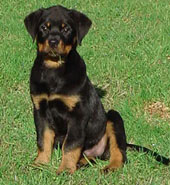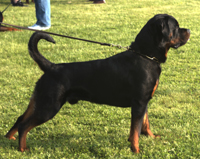Dreibergen Rottweilers
The Rottweiler Natural Tail

What is a Breed Standard?
For each breed of dog, there is a breed standard which is a word description of the perfect dog of that breed. Standards describe the mental and physical characteristics that allow each breed to perform the function for which they were originated. The standard describes the dog's looks, movement and temperament. Breeders involved with each breed are attempting to produce a dog that most closely conforms to the breed standard. In this respect, dog shows are not unlike cat shows, bird shows, cattle shows, horse shows, etc. In fact, for almost every species bred by man there are competitions among breeders. Licensed judges examine the dogs and place them in accordance to how close each dog compares with their mental image of the "perfect" dog as described in the breed's official standard.
The FCI (Fédération Cynologique Internationale) is the World Canine Organization. It has 80 members, almost every country in the world has a Kennel Club that is a member. One National Kennel Club is recognized from each country (the AKC in the US) and that National Kennel Club issues their own pedigrees and trains and licenses their own judges. The FCI also mandates breeding rules and a Code of Ethics to be followed by breeders of each member country.
The FCI recognizes 337 breeds, each of them is the 'property' of a specific country (normally the country of origin). The 'owner' countries of the breeds write the breed standard for their breed and the adoption, translation and updating of the standards is carried out by the FCI. The Rottweiler originated in Germany and the ADRK (Allgemeiner Deutscher Rottweiler Klub has the right and responsibility to set, maintain and revise the breed standard for the Rottweiler for the rest of the world.
Why do Rottweilers now have natural tails?
In 1999 the country of Germany passed a law that made it illegal to dock a
dog's tail or crop a dog's ears. The basis for this law was the fact that
the practice of docking and cropping was deemed to be inhumane treatment of animals.
In order to comply with the new law, the ADRK revised the
Breed
Standard for the Rottweiler and this new breed standard required a natural tail.
The FCI translated and adopted the new breed standard and gave
all FCI member countries several years to comply with the new breed standard.
A docked Rottweiler does not conform to the FCI breed standard. As each FCI member country finalizes their adoption of the new breed standard Rottweiler breeders in those countries will no longer be allowed to dock and docked Rottweilers will be disqualified at shows and prohibited from breeding.
The AKC (American Kennel Club) is not a member of the FCI. AKC does not follow any of the rules and regulations set by the FCI for the rest of the world and the AKC breed clubs do not always follow the breed standards set by the countries of origin. The AKC Breed Standard for the Rottweiler has always deviated from the FCI standard and they are currently struggling to deal with the breed standard regarding the tail.
There are a number of Rottweiler breeders in the United States that follow the FCI Code of Ethics for breeding and strictly follow the FCI/ADRK Breed Standard for the Rottweiler and those breeders will all leave natural tails on their dogs. The United States Rottweiler Club prohibits it's members from docking.

American Veterinary Medical Association Position Statement on Tail Docking
The AVMA has revised their position statement on tail docking and ear cropping several times in recent years.
In June 2005 the AVMA issued this position statement -
"Ear cropping and tail docking in dogs for cosmetic reasons are not medically indicated
nor of benefit to the patient. These procedures cause pain and distress, and, as with all
surgical procedures, are accompanied by inherent risks of anesthesia, blood loss, and
infection. Therefore, veterinarians should counsel dog owners about these matters before
agreeing to perform these surgeries"
In November of 2008 the AVMA revised their position with this strong statement-
"The AVMA opposes ear cropping and tail docking of dogs when done solely for cosmetic
purposes. The AVMA encourages the elimination of ear cropping and tail docking from
breed standards." This
AVMA
position statement was reaffirmed by the AVMA in November 2012.
The World Small Animal Veterinary Association’s position on tail docking
The WSAVA considers amputation of dogs' tails to be an unnecessary surgical procedure and contrary to the welfare of the dog. The WSAVA recommends that all canine organizations phase out any recommendations for tail amputation (docking) from their breed standards. The WSAVA recommends that the docking of dogs’ tails be made illegal except for professionally diagnosed therapeutic reasons, and only then by suitably qualified persons, such as registered veterinarians, under conditions of anesthesia that minimize pain and stress.

What is tail docking?
Tail docking is the amputation of a dog's tail at varying lengths to suit the recommendations of a breed Standard. Docking involves the amputation of the puppy's tail either with scissors, a knife or with a rubber band. The cut goes through many highly sensitive nerves in the tissues including skin, cartilage, and bone. This procedure is usually performed without any anesthetic at between three to five days of age. The procedure can be performed by either a registered veterinary surgeon or by an experienced dog breeder. In many countries veterinarians are declining to perform this procedure, meaning that breeders are now docking more dogs.
Is tail docking painful for the puppy?
Yes, there is strong evidence that this is the case. The puppy has a fully developed nervous system and a well-developed sense of pain. Puppies scream during the procedure and they whimper, whine and cry following docking. During the recovery stage they do not eat well and gain less weight than undocked puppies. Some veterinarians condemn the practice and refuse to perform the procedure because it is totally unnecessary and can lead to serious complications. Some veterinarians continue perform tail amputation reluctantly in order to keep the procedure under professional supervision, please their clients and to minimize the risk to the pups.
Does tail docking prevent tail injuries?
The vast majority of all dogs have natural tails. There is no movement in natural tailed purebred breeds to remove the tail in order to prevent injuries. When tails remain intact, there are no more tail injuries in breeds that were customarily docked than in any other breeds of dog, which includes mix breed dogs!
Can docking cause problems in later life?
There is considerable scientific evidence that docking can lead to complications, including hemorrhage, infection and occasionally death of the puppy. In later life the stump of the tail may be painful due to the formation of neuroma (nerve tissue scar) in the stump. This also occurs following amputation of limbs in people and causes considerable discomfort. Dogs have evolved into their current shape over many thousands of years. If a tail were not useful to a dog, natural selection would have eliminated it long ago. Indeed, tails have many useful functions and are important for balance and body language among other things.

Are tailed Rottweilers different?
Certainly not! In fact once people get used to seeing dogs with their natural tails, the docked dogs look strange, like something is missing. Once you own a tailed Rottweiler it is hard to understand why the tails of this breed were ever amputated in the first place. They use their tails for balance and agility and most importantly, expression and communication. Try to imagine if the reverse happened and you saw a breed such as Labrador retriever with a docked tail. The dog would look quite strange without a tail and you would wonder why the procedure was done.
This article is protected by copyright and may not be reproduced online or in print, in whole or in part without prior consent of the authors.